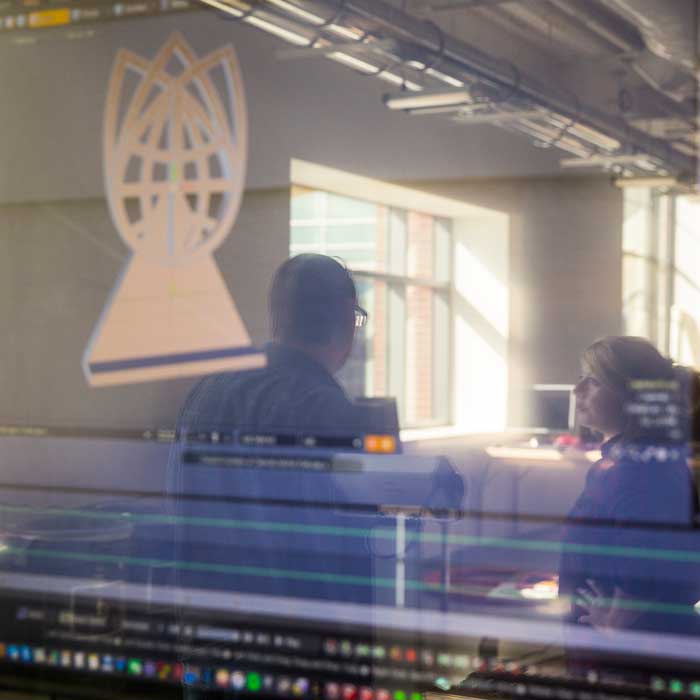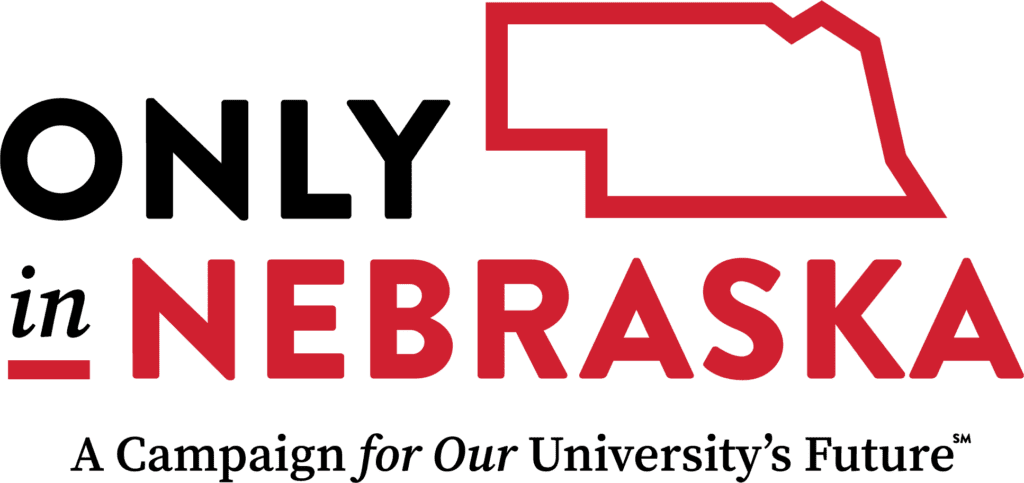Making it happen


Making it happen
Collaboration at the heart of UNL’s maker space.
The first Christmas gift Alfred Tsubaki remembers was a tool kit.
This was back when his family lived in Massachusetts, in a home up the hill from the ocean. He was no older than 5.
He built about 10 birdhouses right away. Some fell apart right away. But the ones that didn’t he took outside and hung on trees, on branches he could reach.
Alfred was 9 when his family moved to Nebraska, where his mom had grown up. He continued to make things. As a mechanical engineering major at UNL, he became fascinated with super-fast lasers and how they interacted with different metals and semiconductors. Last spring, he and a friend graduated as the first UNL students ever to earn a minor in robotics. He’s now a new grad student at UNL, studying electrical engineering.
Some people, like Alfred, were just made to make things.
Makers.
Some places are made with them in mind.
Maker spaces.
The idea is taking flight across the country and igniting ideas and collaborations that wouldn’t otherwise happen.
UNL has such a space in Nebraska Innovation Studio, which just opened its doors this past October on Nebraska Innovation Campus in a renovated building on the old state fairgrounds north of City Campus.
In the space, people like Alfred have begun to gather and collaborate and inspire one another – artists, engineers, students, faculty, alumni and members of the community who are makers, too. In the past, such people usually worked alone or with people of similar backgrounds in their art studio or laboratory or garage out back.
“I walk into Innovation Studio and see people there helping each other out, just spitting ideas back and forth,” Alfred says. “You have people from all different backgrounds having a say, adding to a project. And they teach classes so people can learn new skills, new ways to do things.
“This collaboration is just mind-blowing. That’s the best part of the studio.”
Alfred joined Nebraska Innovation Studio right away. As a grad student, he pays just $20 a month. (Undergrads pay $15; UNL faculty, staff and post-docs pay $35; and people from the community pay $55.)
He’s learned to use the 3D printer and other tools he never could afford to buy himself. He has everything he needs, he says, to make models and design almost anything he wants.
His first project was a wooden spice rack, a gift for his girlfriend.
“Eventually, I’d like to start my own business,” Alfred says, “and the best place to start it is in the Innovation Studio.”
You walk inside, he says, and you feel like nothing’s out of reach.
***
The first thing you’re likely to see when you walk into Innovation Studio is the face of Liana Owad.
“She’s the face of Innovation Studio,” Alfred says. “She’s a wonderful person, super friendly.”
Liana is an artist. She received her master’s in art in 2014, and not long after that was asked to become the first leader of Nebraska Innovation Studio. She’s learned how to use all of the tools so that she can teach studio members.
“We do have that ‘we can do anything’ attitude, in a way,” she says. “That attitude that nothing seems unobtainable.
“A real exciting attitude comes with this maker space.”
Her background helps her help others. Liana grew up in Pennsylvania to parents who pushed her into different types of hands-on creativity. Her mom loves to draw. Her father is an electrical technician. He raced sprint cars when she was little. He could fix cars and weld. Compressors and other large tools were always around.
In high school, Liana wanted to be a dolphin trainer. She took all of the science classes she could. She finished that track early and had some electives left. That’s when she took art classes and eventually decided to study fine arts.
She came to Lincoln with her husband, a doctoral candidate now in math. They were lucky, she says, to get into the same grad school. She focused on sculpture.
One day she was wandering around the engineering building on campus, looking for someone who could help her figure out the best motor to use to drive a moving sculpture she wanted to hang.
As she was walking through the hallway, she saw a flier announcing a meeting for a new UNL “maker space.”
“I decided I was a ‘maker,’” she says, “and I should probably go to this.”
She became part of the executive team and later was hired as the Innovation Studio’s first director.
Maker spaces, she says, are part of a trend – the Maker Movement – that’s growing across the country as 3D printers and other digital technologies continue to democratize the world of manufacturing. Anyone can be a “maker” if they want to be now, she says, kind of like many people had to be back in the days before mass production and big box stores.
Now, for example, if you need a hook to hang something, you don’t have to go to Target and choose from a limited stock. If you have the right tools within your reach, you can design and produce your own.
Just one-third of maker space is open for now. Eventually, Innovation Studio will grow into its entire 16,000 square feet, and other equipment will be added. The university is trying to raise $4.2 million to expand into that space and buy more equipment.
The university also is planning to create an in-house “business accelerator” and hire a director, who will help the makers get their creations to their customers. Few other maker spaces have that feature, and few have companies and research labs – located in the larger Nebraska Innovation Campus community – so close by.
Nebraskans should be proud of the Nebraska Innovation Studio, says one of the world’s experts on such spaces.
“I’m sure the NIS will grow and flourish,” Ken Stone, director of MIT’s Hobby Shop, which began in 1938 and is perhaps the oldest such maker space in the world.
Stone helped Liana, UNL Engineering Professor Shane Farritor and others at Nebraska to get NIS started. (Farritor, the main visionary behind the studio, had spent a lot of time at the Hobby Shop back in the day getting his Ph.D. in mechanical engineering at MIT.)
“Being part of a much larger innovation center initiative brings together the necessary elements for taking ideas all the way to viable businesses,” Stone says. “All ideas need designs solutions that must be tested multiple times before they are successful.”
Nebraskans should be proud of the space because it can help the Nebraska economy, Liana says, while allowing the interdisciplinary collaboration that a university strives for to actually happen.
Everyone united in a desire to create something cool that wasn’t there before.
Makers.
“They come here because they want to,” she says, “and then they get to experience each other in a different light.”
***
The natural light.
That’s one of the things UNL grad student Erin Schoenbeck likes the most about the space.
She’s an artist, a painter. She grew up in “a maker family,” she says, in Cortland, Nebraska. Her mom is a computer programmer who loves to “up-cycle” furniture. Her dad is an electrician and mechanic. She was always beading or playing with string – “always making things.”
“There’s a lot of natural light in the woodshop. I spent a lot of time there because that is where the laser cutter is.
“It’s nice to see familiar faces now there. We’re slowly building up our member base. I’m meeting a lot of new people I’d never meet otherwise, without this space. It’s great to see their work as well.”
She was part of one of the makers’ first big collaboration, which arose because of a request from the chancellor:
Make a device that will cut the ribbon for a private ceremony before the grand opening of Nebraska Innovation Campus.
***
The makers met. They came up with ideas. They agreed they wanted to make something more than just a ribbon-cutter.
They wanted to make something cool happen, too.
The concept they chose came from Gregg Johnson, who was one of the first people from the community to join Innovation Studio. He based his idea on the Innovation Campus logo – the machine would be giant; the three pieces of the logo would rotate and became other things, like a rocket ship and an eye; those rotating pieces would eventually ignite a spark, and that spark would cut the ribbon in two.
Engineering students, designers and programmers developed the electronics for it. Fine artists, including Liana and Erin, designed the faces of the rotating logo pieces.
Erin used the Innovation Studio’s laser-cutting machine to cut tiny pieces of vinyl that’d she’d painted to look like upholstery, using a Trompe-l’oeil technique. (Another artist actually did upholster her section with fabric, Erin says, which was cool.)
On Oct. 8, a day before the official grand opening, VIPs arrived at Innovation Campus for the private ceremony. The chancellor came. So did the NU president.
The giant ribbon-cutting device was to run the entire time of the ceremony. That was the plan. But at the last second, people realized that the sound of its motor might drown out the speakers. So the engineering students modified its code.
And the makers crossed their fingers.
Says Erin: “We were all really nervous it wouldn’t work.”
The speakers spoke. When the time was right, the motor began and the pieces began to rotate.
Then a spark rose …
… closer and closer to the ribbon …
… and ignited it …
… and cut the ribbon in two!
“It was great to see people’s reaction,” Erin says. “A lot of people worked on that one machine, about 10 artists and maybe as many engineers.
“It was fun to have that big gesture be the first big project that we all worked on together in this space.”
The Innovation Studio is just one way the University of Nebraska is helping our students – our future – collaborate and create great things for our future.
If you would like to support the “Our Students, Our Future” fundraising initiative, please contact the University of Nebraska Foundation at 800-432-3216. The two-year, $200 million “Our Students, Our Future” initiative runs through 2017. As of the end of April 2016, it has raised $63.6 million for all campuses at the University of Nebraska.





